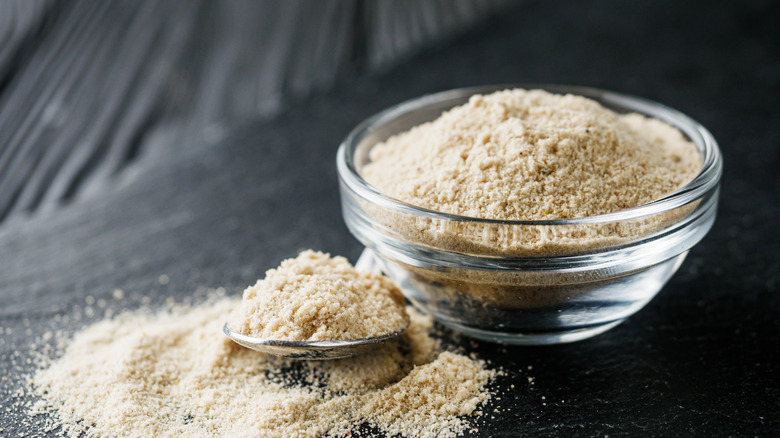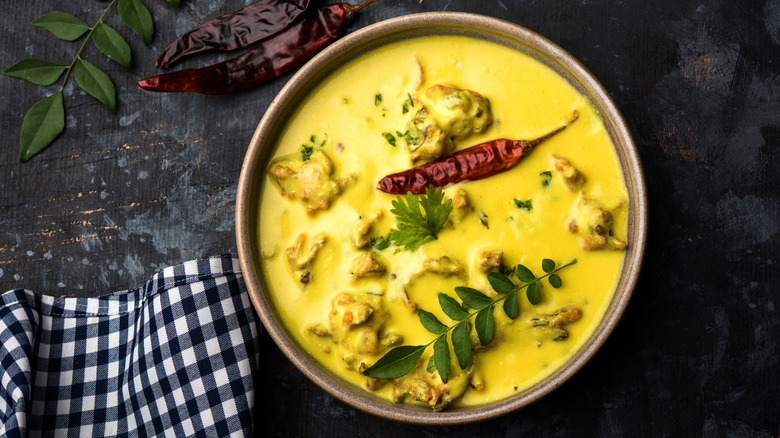The Indian Ingredient You Need For More Authentic Butter Chicken
Some ingredients are so evocative of particular cuisines. Lemongrass brings to mind Thai cooking, while basil is associated heavily with Italian recipes. For Indian cuisine, however, it is a little harder to pin it down to specific ingredients. Indian cuisine uses combinations of spices, generally referred to as "masala". Individually, masala spices are often found in other cuisines around the world. Popular masala spices include fennel seeds, which can be found in European sausages; cinnamon, commonly used in Mexican desserts; and black pepper, which is one of the most ubiquitous spices worldwide.
That said, there is one ingredient that is so distinctly Indian that it immediately adds an air of authenticity to a dish, and that is asafoetida. It is a powder made from the dried resin of a plant from the carrot and fennel family, and adding just a pinch of it to your butter chicken can turn it from a regular homemade dish to a bona fide restaurant-quality meal. Also called hing, asafoetida is not as well-known outside of South Asia as many other spices. Like these other spices, it is not generally used in isolation, but rather as part of the "masala" of a dish. Though it contains no sodium, it is often likened to salt in its ability to bring out all of the other flavors in a recipe. Yet, its sulfurous scent and allium flavor are unmistakable and it plays an important part in the flavor of many classic Indian dishes.
What is asafoetida?
Why is asafoetida not more famous outside of India? The possible reason may be in the name itself — it literally means "stinky gum." Its pungent smell tends to put off potential cooks and eaters but the spice mellows out into a wonderful onion-y flavor when cooked. This flavor is the exact reason that many vegetarians are attracted to Indian cuisine, especially some Brahmin Indians and devout practitioners of Jainism who avoid root vegetables. With asafoetida, Jain adherents can have onion-like flavors in their food without harvesting and consuming onions. If one were unable to eat alliums for other reasons such as allergies, they would benefit as well.
Whether the dish is vegetarian or not, it is important to bloom the asafoetida in fat first to tame its scent and coax out its flavor. You can add it to butter, oil, or melted ghee, but don't let it cook for more than about 15 seconds or it will burn. As soon as it's toasted you can add other ingredients to slow the cooking process. The longer it's cooked, the milder its intense umami flavor will become. It is definitely not a spice that can be sprinkled on after cooking, as it would smell and taste much too strong to be enjoyable.
How else do you use asafoetida?
A pro tip: If you do decide to incorporate asafoetida into your pantry, it must be kept in an airtight container in case its strong odor seeps into neighboring spice jars. The flavor becomes less intense over time. However, once you have it around, a small jar of the stuff goes a very long way, as you only need a tiny pinch each time to flavor entire dishes.
Start your asafoetida experiments with dishes that traditionally call for it, such as sambar (Indian vegetable stew) and various lentil dishes. Aam dal, or raw mango lentil soup, uses asafoetida in its tadka. You can also use it to make vegetarian versions of classic meat dishes like this vegetarian rogan josh.
However, do not feel like you have to limit yourself to just Indian cooking! Try it in place of (or alongside) onions and/or garlic in other dishes by adding a dash to dishes as simple as scrambled eggs or as elaborate as casseroles. As it is also used to counter the effects of bloating that happen with some foods like brassicas and legumes, including it in those recipes may help with indigestion — a tasty bonus!


